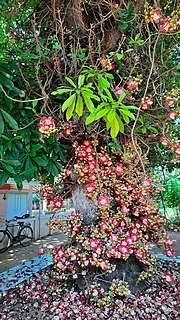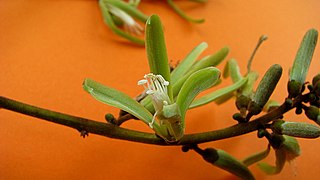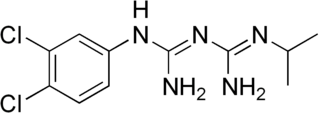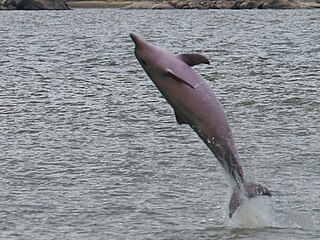
Malaria is a mosquito-borne infectious disease that affects humans and other animals. Malaria causes symptoms that typically include fever, tiredness, vomiting, and headaches. In severe cases, it can cause yellow skin, seizures, coma, or death. Symptoms usually begin ten to fifteen days after being bitten by an infected mosquito. If not properly treated, people may have recurrences of the disease months later. In those who have recently survived an infection, reinfection usually causes milder symptoms. This partial resistance disappears over months to years if the person has no continuing exposure to malaria.
Antimalarial medications or simply antimalarials are a type of antiparasitic chemical agent, often naturally derived, that can be used to treat or to prevent malaria, in the latter case, most often aiming at two susceptible target groups, young children and pregnant women. As of 2018, modern treatments, including for severe malaria, continued to depend on therapies deriving historically from quinine and artesunate, both parenteral (injectable) drugs, expanding from there into the many classes of available modern drugs. Incidence and distribution of the disease is expected to remain high, globally, for many years to come; moreover, known antimalarial drugs have repeatedly been observed to elicit resistance in the malaria parasite—including for combination therapies featuring artemisinin, a drug of last resort, where resistance has now been observed in Southeast Asia. As such, the needs for new antimalarial agents and new strategies of treatment remain important priorities in tropical medicine. As well, despite very positive outcomes from many modern treatments, serious side effects can impact some individuals taking standard doses.

Artemisinin and its semisynthetic derivatives are a group of drugs used against malaria due to Plasmodium falciparum. It was discovered in 1972 by Tu Youyou, who shared the 2015 Nobel Prize in Physiology or Medicine for her discovery. Treatments containing an artemisinin derivative are now standard treatment worldwide for P. falciparum malaria as well as malaria due to other species of Plasmodium. Artemisinin is isolated from the plant Artemisia annua, sweet wormwood, a herb employed in Chinese traditional medicine. A precursor compound can be produced using a genetically-engineered yeast, which is much more efficient than using the plant.

Couroupita guianensis, known by a variety of common names including cannonball tree, is a deciduous tree in the flowering plant family Lecythidaceae. It is native to the tropical forests of Central and South America, and it is cultivated in many other tropical areas throughout the world because of its beautiful, fragrant flowers and large, interesting fruits. Fruits are brownish grey. There are medicinal uses for many parts of Couroupita guianensis, and the tree has cultural and religious significance in India.

Lactucopicrin (Intybin) is a bitter substance that has a sedative and analgesic effect, acting on the central nervous system. It is a sesquiterpene lactone, and is a component of lactucarium, derived from the plant Lactuca virosa, as well as being found in some related plants such as Cichorium intybus. It is also found in dandelion coffee.

Simaba cedron, the cedron, is a member of the quassia family, Simaroubaceae, native to Colombia and Central America.

Simala is a comune (municipality) in the Province of Oristano in the Italian region Sardinia, located about 60 kilometres (37 mi) northwest of Cagliari and about 30 kilometres (19 mi) southeast of Oristano.

The crested eagle is a large Neotropical eagle.
Perebea is a genus of plant in family Moraceae.

Akuammine (vincamajoridine) is an indole alkaloid. It is the most abundant alkaloid found in the seeds from the tree Picralima nitida, commonly known as akuamma, comprising 0.56% of the dried powder. It has also been isolated from Vinca major. Akuammine is structurally related to both yohimbine and mitragynine, both of which are alkaloid plant products with pharmacological properties.
Bagassa guianensis is a tree in the plant family Moraceae which is native to the Guianas and Brazil. It is valued as a timber tree and as a food tree for wildlife. The juvenile leaves are distinctly different in appearance from the mature leaves, and were once thought to belong to different species.

Chlorproguanil is an antimalarial drug.

Pyronaridine is an antimalarial drug. It was first made in 1970 and has been in clinical use in China since the 1980s.

Arterolane, also known as OZ277 or RBx 11160, is a substance that was tested for antimalarial activity by Ranbaxy Laboratories. It was discovered by US and European scientists who were coordinated by the Medicines for Malaria Venture (MMV). Its molecular structure is uncommon for pharmacological compounds in that it has both an ozonide (trioxolane) group and an adamantane substituent.

The dolphin genus Sotalia is considered to have two member species with the classification of Sotalia guianensis as a distinct species from Sotalia fluviatilis in 2007. This was a result of recent morphometric analyses, as well as mitochondrial DNA analysis.

Uncaria guianensis, cat's claw, is a plant species in the genus Uncaria found in the Amazon biome. Other names for the plant include uña de gato, Paraguayo and vincaria.

Carapa guianensis is a species of tree in the family Meliaceae, also known by the common names andiroba or crabwood.

The Guiana dolphin, also known as the estuarine dolphin or costero, is a dolphin found in the coastal waters to the north and east of South America, and east of Central America. It is a member of the oceanic dolphin family (Delphinidae). It can live in both saltwater and freshwater.

Myrcia guianensis (pedra-ume-caá) is a species of the flowering plant family Myrtaceae. It is found in South America.
















